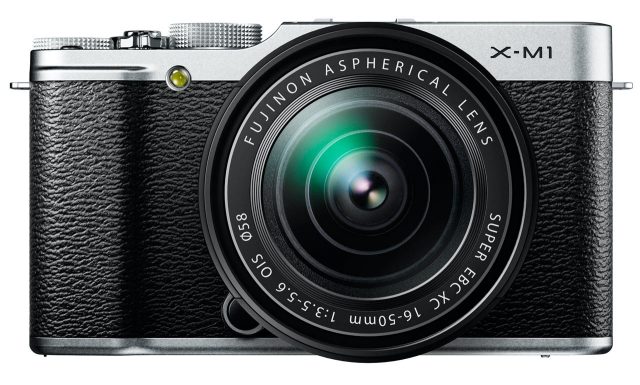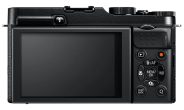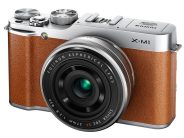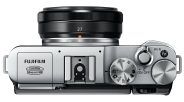Announced
Production status
System
Fujifilm X system cameras
- Fujifilm X-A1
- Fujifilm X-A10
- Fujifilm X-A2
- Fujifilm X-A20
- Fujifilm X-A3
- Fujifilm X-A5
- Fujifilm X-A7
- Fujifilm X-E1
- Fujifilm X-E2
- Fujifilm X-E2S
- Fujifilm X-E3
- Fujifilm X-E4
- Fujifilm X-H1
- Fujifilm X-H2
- Fujifilm X-H2S
- Fujifilm X-M1
- Fujifilm X-Pro1
- Fujifilm X-Pro2
- Fujifilm X-Pro2 Graphite Edition
- Fujifilm X-Pro3
- Fujifilm X-S10
- Fujifilm X-S20
- Fujifilm X-T1
- Fujifilm X-T1 Graphite Silver Edition
- Fujifilm X-T10
- Fujifilm X-T100
- Fujifilm X-T2
- Fujifilm X-T2 Graphite Silver Edition
- Fujifilm X-T20
- Fujifilm X-T200
- Fujifilm X-T3
- Fujifilm X-T30
- Fujifilm X-T30 II
- Fujifilm X-T4
- Fujifilm X-T5
- Fujifilm X-T50
Fujifilm X-M1
APS-C AF digital mirrorless camera • Discontinued
Specification
| Format: | |
| APS-C | |
Imaging sensor: | 23.6 × 15.6mm X-Trans CMOS sensor |
Resolution: | 4896 × 3264 - 16 MP |
Crop factor: | 1.53x |
Sensor-shift image stabilization: | - |
| Fujifilm X [17.7mm] | |
| Shutter: | |
Type: | Focal-plane |
Model: | Electronically controlled |
Speeds: | 30 - 1/4000 + B |
| Exposure: | |
Exposure metering: | Through-the-lens (TTL), open-aperture |
Exposure modes: | Programmed Auto |
| Aperture-priority Auto | |
| Shutter-priority Auto | |
| Manual | |
| Physical characteristics: | |
Weight: | 330g |
Dimensions: | 116.9x66.5x39mm |
Manufacturer description
FUJIFILM Corporation (President: Shigehiro Nakajima) is proud to announce the launch of the FUJIFILM X-M1, the third premium interchangeable-lens camera from the company. Compact and lightweight, the X-M1 offers enhanced operability whilst bringing the outstanding design, picture quality and performance of the multi-award-winning FUJIFILM X-Pro1 and X-E1 cameras not only to photo enthusiasts but also to a broader scope of users.
Featuring the same internationally-acclaimed proprietary multi-award-winning 16.3 megapixel APS-C X-Trans CMOS Sensor as the FUJIFILM X-Pro1 and FUJIFILM X-E1
The FUJIFILM X-M1 is equipped with a large APS-C X-Trans CMOS Sensor, which offers picture quality comparable to that of full-frame sensors. The sensor’s unique colour filter array minimises moiré and chromatic aberration without the need for an optical low pass filter, while dramatically boosting resolving power even at identical pixel counts to deliver sharp and texture-rich pictures.
The design draws out the potential of high-performance lenses to the maximum. It delivers clear images with stunningly low noise even in low-light conditions at night and indoors, where high sensitivity would usually be required. The sensor faithfully reproduces the warm tones of human skin and the vivid colours of the sky from deep blues to the red hues of the setting sun.
Users can set the sensor sensitivity from the regular ISO200 to as high as ISO6400 in 1/3 step increments, and can even take advantage of the extended range of ISO12800 and ISO25600 to obtain incredibly clear and low-noise images even in low-light or at night.
Fujifilm EXR Processor II for high-speed reactions
The EXR Processor II boasts fast performance, offering stress-free photo capture with its:
- start-up time of 0.5 seconds (*1)
- shutter time lag of 0.05 seconds
- maximum burst speed of 5.6 frames per second (max. 30 frames*2)
Designed to enable one handed operation with intuitive and quick selection of functions for casual shooting with beautiful results
All of the adjustable buttons and dials are positioned on the right-hand side of the camera’s rear LCD panel in pursuit of optimum operability and ease-of-use for casual shooting. When holding the camera with just your right hand, the placement of the buttons has been designed to allow you to access all functions and adjust the settings easily.
The Mode Dial allows you to select the optimum scene setting with access to the “Advanced SR Auto” function, which automatically recognises a scene type for fail-safe photography, and the “Advanced Filter” function for artistic photographic effects.
The camera is equipped with two Command Dials, allowing users to adjust the aperture, shutter speed and exposure compensation quickly with their thumb. Individual buttons are also provided to access frequently-used functions such as White Balance, Burst Mode and Macro, so that you don’t have to go to the menu screen for each change of setting, enabling an intuitive and quick operation.
Sporting a compact and lightweight body, with a cool, retro design inherited from the FUJIFILM X-Pro1 and X-E1
The X-M1 has a classical and elegant feel just like the popular FUJIFILM X-Pro1 and X-E1 cameras. And importantly, at about half the size of a regular SLR body (66.5mm high and 39.0mm deep), its compact and lightweight design means users can casually carry it in a bag without having to worry about the bulk.
The X-M1 weighs just 330 grams(*3) despite incorporating a large APS-C CMOS sensor, a tiltable high-definition LCD monitor, a built-in flash, Wi-Fi and a hot shoe.
The X-M1 is available in three colours: Black, Silver and Brown.
Featuring a 920,000 dot high definition tiltable 3-inch LCD for creative and multi-angle shots
The 3-inch high-definition LCD screen tilts up and down, facilitating ground level shots of flowers and pets, as well as high-up shots over a crowd of people. It is also suited to tripod-mounted video shooting to broaden your creative options.
FUJIFILM’s Super i-Flash technology which regulates flash intensity according to the scene
The X-M1’s high-precision built-in flash, rated at the equivalent of Guide Number 7 (*4), uses FUJIFILM’s Super i-Flash technology to regulate the amount of light it fires dependent on the scene. In low-light indoor portrait shots or for close-ups of accessories / plates of food, the flash controls its output to reduce highlight blowout. It also provides the perfect fill-in flash when photographing people in backlit conditions or under intense sunlight casting strong shadows on the face.
Wireless image transfer allowing you to instantly transfer high quality images to a mobile device or computer
The wireless image transfer function allows users to transfer their shots immediately to their smartphone or tablet PC. It broadens the enjoyment of photography through the easy uploading of your favourite images to social networking sites or just enabling you to share them with your friends.
The camera has a built-in wireless image transfer function that uses the dedicated “FUJIFILM Camera App”, available as a free download, to instantly transfer and save your favourite photos to a smartphone or tablet PC. Beautiful images of your choice can be transferred with the Wi-Fi button ready for uploading to SNS or sharing with friends.
Users can also view and import pictures and videos to the camera from a smartphone or tablet PC. The function can also retrieve location data from your smartphone to add the information to pictures you take.
Additionally a PC Autosave feature is available, via Wi-Fi® (*5), this provides a simple means to back up your photos to your home PC. Just install the free “FUJIFILM PC AutoSave” software onto your PC and select which folder you want the photos to back up to, and then by linking your Wi-Fi Router and the X-M1 you will have set up a very simple to use backup for your photos on your home PC. Both incredibly useful and a big timesaver!
Get creative with your photography by employing popular special effects in-camera
With eight advanced Art Filters, users can add special effects pre-image capture: namely Toy Camera, Miniature, Dynamic Tone, Pop Colour, Soft Focus, High Key, Low Key and Partial Colour. The camera also offers a Multiple Exposure mode which allows you to superimpose a second exposure onto the first exposure for a truly creative touch.
Additionally, Fuji’s Film Simulation modes feature five different effects that emulate the looks that used to be captured by different photographic films: i.e. Provia (standard) for natural colour reproduction, Velvia (vivid) for saturated tones, Astia (muted) for soft graduation, and Sepia and Black & White.
Full HD video recording
The FUJIFILM X-M1 is capable of full HD (1920x1080) video recording at 30 frames per second. Creative effects can be added when shooting videos with Film Simulation options including Monochrome and beautiful bokeh achieved with the large sensor at a large aperture.
FUJIFILM X-M1 Key Features:
- 16.3 megapixel APS-C X-Trans CMOS sensor (same sensor as X-Pro1/X-E1)
- Hi-speed EXR Processor II
- Start-up time of 0.5secs (*1), shutter lag of 0.05secs and a maximum burst speed of 5.6fps (max. 30 frames (*2))
- Compact and lightweight body (half the size of an SLR)
- Tiltable 3-inch LCD (920K dot high definition)
- Built in flash with FUJIFILM’s Super i-Flash technology
- ISO200-6400 in 1/3 step increments (and extended range of ISO 12800 to 24600 at reduced resolution)
- Full HD Video recording at 30fps
- 49 point AF
- Art filters: 8 Advanced Filters plus 5 Film Simulation modes
- In-camera RAW processing
- Q button for list view of frequently-used menus and smooth configuration
- Hot shoe
- Wireless image transfer to smart phones and tablet PCs via FUJIFILM Camera app
- PC Autosave Wi-Fi® (*5) connectivity to PCs (for easy image backup)
- The X-M1 camera is available in three colours: Black, Silver and Brown
- Fujifilm X mount (compatible with all FUJINON XF / XC / Zeiss X mount lenses)



